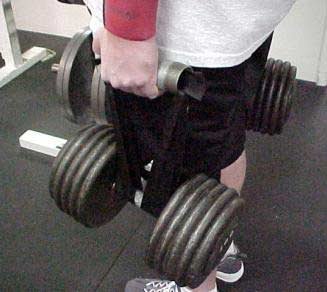There are a variety of ways to perform or set up this event. Variables include the weight used per hand, the distance that must be traveled and the route. As far as the weight goes, you may see weights used from 180 lbs per hand to 330 pounds per hand, depending on the level of the athlete that is being tested. When it comes to distance, this is related to the weight. If the weight is on the lighter end of the above mentioned, the distance will be farther. For example, the weight may be 220 pounds per hand, while the distance is 125-250 feet. The weight may not seem like much, but after that distance the hand and forearm grip tires quickly.
As for the route, often times the distance traveled includes turns. It may be a 90-degree turn or 180-degree turn. The athlete may have to go 200 feet total - 100 ft. down, turn around and go back to the start line. This turn is a very difficult thing to deal with then you have your body's momentum and 400-plus pounds going as well. Any combination of the above variables may be used. One competition used 330 pounds per hand and each athlete had to first lift the weight (remember that's a 660-pound deadlift) and then they would go as far as possible. Some may go 5 feet, some 50-plus feet! Other times, when smaller or newer athletes are involved, the weight will be around 200 pounds and the distance 100-150 feet without a turn.
Another issue that is involved is setting the weight down. When the grip and upper back tires, an athlete may drop the weights and rest for a few moments then proceed on. Some competitions allow unlimited drops and some only allow one or two. When time is involved, each time that the weights are dropped, more time goes by. Therefore, a good grip and proper practice and technique are crucial for success.
THE IMPLEMENTS
There is one popular source for strongman equipment. Mastiff Strength Equipment (www.mastiffstrength.com) is a great source of outstanding quality products. However if money is an issue, this may not be a viable option for you. To get the training benefit of grip, back and leg strength as well as agility by practicing the farmers carry event or to improve you technique for a future competition, you must practice. If you cannot afford the equipment, I've come up with a reasonably priced option. This is a more life-like option that replicates the feel of a farmer's carry implement - better than a set of dumbbells anyway.
You'll need:
-
1. 12+ feet of nylon webbing or steel cable
2. 2 pieces of pipe (6' X 1 3/4") (they call them "nipples" in the plumbing dept)
3. 2 pieces of pipe (6' X 1 1/4")
Cut the length of webbing or cable into two pieces. Tie the ends together so you have a loop/circle. Pinch one part of the loop together and thread it through the pipe so it looks like an "8" with the pipe in the middle of the "8".

Once you have each loop hanging out of the pipe at each end and the knot or connection point inside the pipe, loop each loop around each end of the dumbbell you want to use. In the picture below, a 100-pound dumbbell is being used. The great part about this is that you can remove it after you're done training and take it with you. You can also go to lighter or heavier dumbbells in the same workout with relative ease. To make the change easier, put large hooks on each loop so you can easily attach and detach the apparatus to a dumbbell or barbell.

Here you can see the nylon webbing (like a seatbelt) used with 100-pounders.

Here an athlete is dong shrugs with the apparatus attached to dumbbells. This trains the traps and grip as well as gives the person the "feel" of the farmers walk.
Good luck with your training and email me with any questions. Thanks to Chad Coy, Heath Otto, Met-Rx and the staff of Bodybuilding.com!
Train hard!
